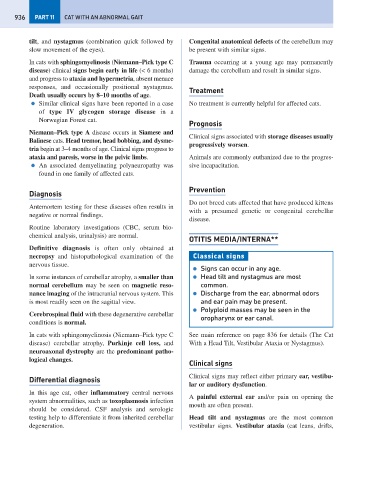Page 944 - Problem-Based Feline Medicine
P. 944
936 PART 11 CAT WITH AN ABNORMAL GAIT
tilt, and nystagmus (combination quick followed by Congenital anatomical defects of the cerebellum may
slow movement of the eyes). be present with similar signs.
In cats with sphingomyelinosis (Niemann–Pick type C Trauma occurring at a young age may permanently
disease) clinical signs begin early in life (< 6 months) damage the cerebellum and result in similar signs.
and progress to ataxia and hypermetria, absent menace
responses, and occasionally positional nystagmus.
Treatment
Death usually occurs by 8–10 months of age.
● Similar clinical signs have been reported in a case No treatment is currently helpful for affected cats.
of type IV glycogen storage disease in a
Norwegian Forest cat.
Prognosis
Niemann–Pick type A disease occurs in Siamese and
Clinical signs associated with storage diseases usually
Balinese cats. Head tremor, head bobbing, and dysme-
progressively worsen.
tria begin at 3–4 months of age. Clinical signs progress to
ataxia and paresis, worse in the pelvic limbs. Animals are commonly euthanized due to the progres-
● An associated demyelinating polyneuropathy was sive incapacitation.
found in one family of affected cats.
Prevention
Diagnosis
Do not breed cats affected that have produced kittens
Antemortem testing for these diseases often results in
with a presumed genetic or congenital cerebellar
negative or normal findings.
disease.
Routine laboratory investigations (CBC, serum bio-
chemical analysis, urinalysis) are normal.
OTITIS MEDIA/INTERNA**
Definitive diagnosis is often only obtained at
necropsy and histopathological examination of the Classical signs
nervous tissue.
● Signs can occur in any age.
In some instances of cerebellar atrophy, a smaller than ● Head tilt and nystagmus are most
normal cerebellum may be seen on magnetic reso- common.
nance imaging of the intracranial nervous system. This ● Discharge from the ear, abnormal odors
is most readily seen on the sagittal view. and ear pain may be present.
● Polyploid masses may be seen in the
Cerebrospinal fluid with these degenerative cerebellar
oropharynx or ear canal.
conditions is normal.
In cats with sphingomyelinosis (Niemann–Pick type C See main reference on page 836 for details (The Cat
disease) cerebellar atrophy, Purkinje cell loss, and With a Head Tilt, Vestibular Ataxia or Nystagmus).
neuroaxonal dystrophy are the predominant patho-
logical changes.
Clinical signs
Clinical signs may reflect either primary ear, vestibu-
Differential diagnosis
lar or auditory dysfunction.
In this age cat, other inflammatory central nervous
A painful external ear and/or pain on opening the
system abnormalities, such as toxoplasmosis infection
mouth are often present.
should be considered. CSF analysis and serologic
testing help to differentiate it from inherited cerebellar Head tilt and nystagmus are the most common
degeneration. vestibular signs. Vestibular ataxia (cat leans, drifts,

